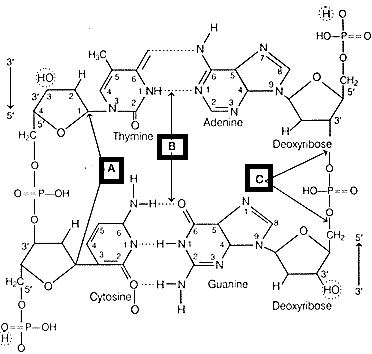Experiments in Search of Genetic Material
Experiments in Search of Genetic Material: Overview
This topic covers concepts such as Evidence of DNA as Genetic Material, Griffith Experiment, Avery Experiment, Hershey and Chase Experiment, DNA, Chemical Composition of DNA, Properties of Genetic Material, etc.
Important Questions on Experiments in Search of Genetic Material
The series of experiments done by F. Griffith involved which of the following bacterium:
MacLeod, McCarty and Avery determined that R strain bacteria transforming into S strain bacteria because of:
Experiments of Griffith on mice explained the phenomenon of:
Arrange the following biological discoveries in the correct chronology from the earliest to the latest.
i. British biochemist Frederick Sanger introduces his 'plus and minus' method for DNA sequencing.
ii. American scientists Walter Gilbert and Allan Maxam introduce their method of DNA sequencing using chemical processes to terminate DNA strands.
iii. Swiss physician Friedrich Miescher discovers and isolates DNA
iv. Canadian-American researchers Oswald Avery and Colin Munro MacLeod, along with American geneticist Maclyn McCarty, working on experiments on pneumococcal bacteria, establish that DNA could transform the properties of cells.
v. American biologist James Watson and English physicist Francis Crick discover the double helix when solving the three-dimensional structure of DNA, working from crystallographic data produced by Rosalind Franklin and Maurice Wilkins.
In an experiment, bacteria were infected with labelled virus in a ratio of . The culture was rigorously shaken followed by centrifugation. Radioactivity was:
Frederick Griffith performed an experiment where mice were killed when injected with a mixture of Heat-Killed -type Streptococcus and Live -type Streptococcus but not with or separately. Mice were killed because
A student isolated a new virus which is able to infect E. coli. The following experiment has to follow to confirm the hereditary material of new virus.
Match the following:
| List - I | List - II | List-III | |||
| (A) | Discovery of genetic material | () | Transforming principle | () | Conjugation |
| (B) | Chromatium | () | Derive energy from the oxidation of an inorganic substance | () | Obtain carbon from the atmosphere |
| (C) | Conservative process | () | Capture light energy | () | S. pneumoniae |
| (D) | Beggiotoa | () | Donor retains a copy of genetic material | () | Obtain carbon from |
The correct answer is :
Arrange the following aspect of a double stranded molecule with the sequence in ascending order
A) Number of phosphodiester bond
B) Number of bonds
C) Number of total pyramidines
Match the following lists:
| List - I | List - II | ||
| Erwin Chargaff | Transforming principle | ||
| Frederick Griffith | Nuclein | ||
| Alfred Hershey | Ratio between and and that between and are constant, each equals one | ||
| Colin MacLeod | Biochemical nature of transforming principle | ||
| as the genetic material that is passed from virus to bacteria | |||
The correct match is
Which of the following experiments with bacteriophages proved that DNA is a genetic material?
Name the oldest animal to live on land?
The DNA of a human is 50% match of which fruit?
In the given diagram of chemical structure of DNA, identify the type of bonding shown by and .

The haploid content of human DNA is ________.
Which of the following isotopes were used in the Hershey-Chase experiments?
What is the inference extracted from Griffith's transformation experiments?
Glycosidic bond exists in DNA molecule between______________
In Griffith's experiments mice died when injected with
The fact that DNA is a genetic material was established by the experiment of:
